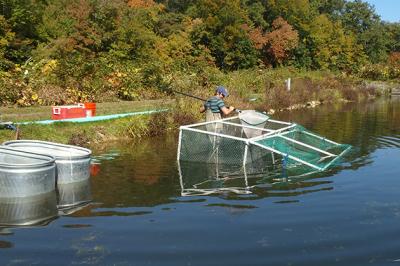Study points to human impact on evolution of freshwater fish

A UConn researcher removes fish from a holding pen in an area protected from fishing. Credit: Jason Vokoun
The most aggressive largemouth bass in the lake are also the ones most prized by anglers. These are the fish that literally 'take the bait' and put the fun into both competitive and casual sport fishing.
Then, according to the rules of catch-and-release, the captive is unhooked and tossed back to swim away without any lasting consequences. But a new UConn study says there is an impact; the evolutionary path of a species may be on the line.
In a recent paper published in the journal PLOS ONE, a team of researchers led by Jan-Michael Hessenauer and Jason Vokoun of the Department of Natural Resources and the Environment, found the practice of catch-and-release appears to influence which fish are the species' fittest.
“This scenario genetically favors the fish with lower metabolisms, the fish that are less likely to be caught by anglers,” Vokoun says. “It suggests that we may be permanently changing exploited fish populations over the long term.”
The potential for recreational fishing to act as an evolutionary force is well established in theory. But this is the first study to identify outcomes of selection from recreational fishing of wild populations using unfished populations as a reference.
Researchers compared populations of largemouth bass in two lakes that are open to recreational fishing and two that have been undisturbed for hundreds of years. Connecticut has significant wild populations of largemouth bass living in protected bodies of water due to stringent management practices enforced by local water companies.
The researchers collected baby fish from the fished and unfished lakes and transferred them to a protected location with no anglers and no predation from larger fish. Prior to being released into the pens, each fish was tagged so it could later be identified by its place of origin.
Despite their different origins, the two populations grew up in the same environment and experienced the same rearing conditions. After one year, the researchers measured the fishes' resting metabolism.
They found that a significantly higher number of fish taken from the lakes where fishing was allowed had lower metabolic rates compared with the fish taken from protected bodies of water.
“The results point to a reduction in the type of behavior that is so prized by anglers,” says Hessenauer, a doctoral student.
Several factors may be influencing this, according to Vokoun, associate professor of natural resources and the environment and director of UConn's Wildlife & Fisheries Conservation Center. Male Largemouth Bass are aggressive nest guarders, and if they are removed permanently, the nest will likely fail.
More aggressive females that are caught and released may suffer physiological stress that results in egg resorption and the production of fewer offspring, he says. If the same fish are caught more than once, their energy levels may be depleted, and typical behavior altered.
Vokoun adds that catch-and-release practices put physiological stress on the fish that can result in the disruption of reproductive behavior, as well as some unintended post-release mortality.
While a catch-and-release strategy may have some unintended drawbacks, Hessenauer and Vokoun don't dispute that it is well intended, or that it does make a contribution to the conservation of freshwater fish populations.
The next step in the research will be to breed fish that come from protected areas with those that come from unprotected areas, with the hope that the offspring will inherit some of the vigor and persistence of their wild kin.
The current findings may have implications for the catch-and-release strategy, says one of the study's co-authors, Robert Jacobs, Eastern District supervisor for the Inland Fisheries Division of the Connecticut Department of Energy and Environmental Protection (DEEP), which funded the study.
“People affect the genetics of plant and animal populations just by the way we interact with them, and this study contributes to a body of knowledge that will help us truly understand how traditional management strategies may become less relevant over time,” he says. “The findings in this study may be a strong signal that we need to be much more creative in the ways we manage our inland fisheries.”
Media Contact
All latest news from the category: Life Sciences and Chemistry
Articles and reports from the Life Sciences and chemistry area deal with applied and basic research into modern biology, chemistry and human medicine.
Valuable information can be found on a range of life sciences fields including bacteriology, biochemistry, bionics, bioinformatics, biophysics, biotechnology, genetics, geobotany, human biology, marine biology, microbiology, molecular biology, cellular biology, zoology, bioinorganic chemistry, microchemistry and environmental chemistry.
Newest articles

NASA: Mystery of life’s handedness deepens
The mystery of why life uses molecules with specific orientations has deepened with a NASA-funded discovery that RNA — a key molecule thought to have potentially held the instructions for…

What are the effects of historic lithium mining on water quality?
Study reveals low levels of common contaminants but high levels of other elements in waters associated with an abandoned lithium mine. Lithium ore and mining waste from a historic lithium…

Quantum-inspired design boosts efficiency of heat-to-electricity conversion
Rice engineers take unconventional route to improving thermophotovoltaic systems. Researchers at Rice University have found a new way to improve a key element of thermophotovoltaic (TPV) systems, which convert heat…



